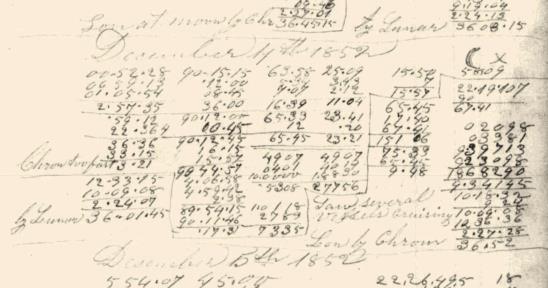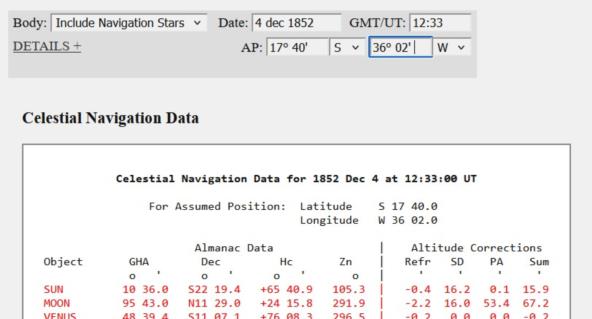
NavList:
A Community Devoted to the Preservation and Practice of Celestial Navigation and Other Methods of Traditional Wayfinding
From: Frank Reed
Date: 2024 May 16, 13:00 -0700
A popular myth about lunars says that they were highly impractical because it took a "math genius" and required four hours of calculation to work one up from a sextant sight to a final longitude. Like all myths, this one has a small basis in fact. Back a few years before the Nautical Almanac was published (so that means before 1767), a would-be lunarian navigator would have to compute the equivalent of the lunar distance table entries longhand from Mayer's tables for the ephemerides of the Moon. That took hours. This was counted not as a bad thing, but as a bit of a miracle. They saw it as "only" four hours to get longitude by working a lunar. After 1767 everything changed, and those "only" four hours became "only" fifteen minutes...
Here's an image from a page in a logbook in 1852. This may have been an American whaleship, but I will have to look it up again. Anyone remember this from an earlier post of mine? In any case, that block of numbers, inscrutable and meaningless as it is at first glance, constitutes one single "longitude by lunar". That fits on a third of a short page of paper! I count 366 digits in various entries on this date. If that work really took four hours, then that would imply approximately 40 seconds to write each digit. A snail could work faster. :) There are many other examples like this. Clearly the myth is wrong, apart from that origin story back before the publication of the original Nautical Almanac. Working a lunar, doing the math and calculation, typically took fifteen to twenty minutes with the right tables available.
So what's going on in this calculation? It's a lunar, of course, so there is a measured angle between the Moon and the Sun (the other body is the Sun in the majority of cases), and there are also measured altitudes for the Sun and the Moon. We can find those in this calculation. Look for a "12" and a "20". These are simple, quick altitude corrections that were standard in this era when working lunars. It's the pre-clearing step for the altitudes. For the Sun, it's add 12 minutes of arc. For the Moon, subtract 20 minutes of arc. See that work? It's near the middle of the page towards the right. There's also a lunar distance close to 90°. When I first looked at this page, I read the date as December 11, 1852. Try it yourself. That's no good because it's New Moon. Looking again, I decided December 4 looked likely. And sure enough, that's a fit. I'm attaching a little bit of data from my "USNO clone" web app for the date and my best estimate of the time and location, which is about 170 nautical miles off the coast of Brazil.
What are all those other numbers? I don't know because I haven't put the effort into it... I haven't investigated this example much further than what I've written above. With this headstart on the date and location, can you puzzle out what's going on in this computation? I'm leaving this as a game, a challenge, a chance to read someone else's bad handwriting from 172 years ago... :)
Frank Reed
Clockwork Mapping / ReedNavigation.com
Conanicut Island USA








